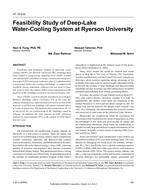Description
Feasibility and utilization benefits of deep-lake watercooling (DLWC) for Ryerson University (RU) buildings havebeen studied by using energy modeling tools. DLWC systemscan substantially contribute to energy conservation and greenhousegas(GHG)emissions reduction when it is substituted forconventional chillers for cooling of buildings. A commerciallyavailable energy simulation software tool was used to simulate,hour by hour, the remote chilled-water requirement of themajority of RU buildings located in downtown Toronto, ON.Since a DLWCsystem is already installed to serve RogersBusiness Building, which constitutes 9% of the total RUcampus building area, implementation of such a system in themajority or all Ryerson buildings will require minimal effortsin terms of initial cost. The analysis showed that up to 89.2%of electricity for air conditioning of RU buildings could bereduced. In addition, the total amount of GHG emissionsreduced by approximately 89% in the amount of 1940 metrictons per year
Citation: 2015 Annual Conference, Atlanta, GA, Transactions 2015, Vol 121 pt. 2
Product Details
- Published:
- 2015
- Number of Pages:
- 9
- Units of Measure:
- Dual
- File Size:
- 1 file , 2.7 MB
- Product Code(s):
- D-AT-15-033




